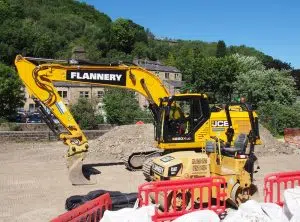
According to the Insolvency Service, there were 307 insolvencies in the construction sector in February 2022, a 142% increase on the 127 insolvencies in the same month last year and a 6% increase on the monthly average for the last quarter of 2021.
Fresh warnings are being made about a spike in insolvencies in the coming months as official figures said the number of construction firms going bust fell in April.
What’s driving the insolvencies in the construction industry?
The construction industry has been hit hard by the current economic downturn. With fewer people buying homes and businesses investing less in new buildings, construction companies have found themselves struggling to stay afloat. One consequence of this financial pressure is an increase in insolvencies, as construction companies are forced to declare Administration or liquidation when they are unable to pay their debts.
While the exact reasons for the current rise in insolvencies vary from company to company, there are several factors that seem to be playing a role. First, the cost of materials and labor has risen sharply in recent years, while the price of finished buildings has remained relatively static. This has put a squeeze on profit margins, making it difficult for construction companies to make ends meet.
Additionally, the number of new projects being started has declined sharply, leaving many companies with idle workers and equipment. Finally, the banking sector has become increasingly risk-averse in recent years, making it difficult for construction companies to obtain financing for new projects. As a result of these factors, many construction companies are finding themselves caught in a downward spiral of debt and insolvency.
Prices of building materials taking affect
Building materials prices were 27% higher in January than pre-pandemic levels, with insolvencies in the sector up 18%. The cost rises as part of “a perfect storm” for smaller contractors, in particular, as the increases have come at the same time as constrained labour availability, increased insurance costs and changes to the tax regime for suppliers.
For social landlords, it is “a very challenging situation”, not least because they are committed to spending money to address fire safety issues and to fulfil their net zero carbon obligations.
“The increases in material and product costs, as well as the increased labour costs, will mean that their resource is spread even more thinly,” . “In addition, the delays to projects due to availability of materials, products and labour mean that there are knock-on effects onto subsequent projects and frameworks, which will then cost more and take longer.”
For clients, the most obvious impact of a contractor going bust is delays. But in a climate of rapidly rising costs, there is a danger that housing associations will have to shell out much more than anticipated to build the homes they have committed to. That is because many deals with contractors are on a fixed-cost basis, but that deal won’t necessarily carry over to a new contractor.
Labour shortages are driving construction wage inflation
The construction industry is facing a number of challenges in the coming years, not least of which is a shortage of workers. With an ageing population and fewer young people entering the sector, the pool of potential employees is steadily shrinking. This is particularly true in skilled trades, such as carpentry and plumbing, where the average age of workers is already quite high.
Construction companies are struggling to fill 100,000 vacant positions due a severe shortage of workers. The problem is expected get worse as the UK moves closer towards an economic recession and many construction unions have called on government officials for intervention before it’s too late
Construction firms report that 77% experience difficulty attracting labor while only 18 percent said things were going well with hiring practices – this figure includes both skilled professionals like plumbers or electricians who often find themselves outbid by less expensive competitors.
The result is that construction firms are being forced to offer higher wages in order to attract and retain staff. In some cases, this wage inflation is already being passed on to customers in the form of higher prices for new homes and office space. As the labour shortage worsens, it is likely that this trend will continue, making it more expensive to build new homes and businesses in the UK.With a shortage of construction workers, it is difficult for companies in the industry to find someone qualified.
In Ireland and Great Britain there has been an increase demand from both wet trades as well as dry ones because 65% reported having difficulty sourcing bricklayers or carpenters respectively; this trend may continue if these trends do not turn around soon with new shortages expected due into 2023.
Covid has had a devastating effect on the construction industry, with many apprenticeship training centres going into hibernation and taking almost two years worth of new workers. The latest PwC report estimates that over 82% survey respondents in this sector said they have seen decreased availability for trades due to Covid’s impact.”
Rising costs see 142% increase in construction firms going out of business compared with last year – and warnings of more to come.
Read more: J Tomlinson gone into administration
With over three decades of experience in the business and turnaround sector, Steve Jones is one of the founders of Business Insolvency Helpline. With specialist knowledge of Insolvency, Liquidations, Administration, Pre-packs, CVA, MVL, Restructuring Advice and Company investment.
